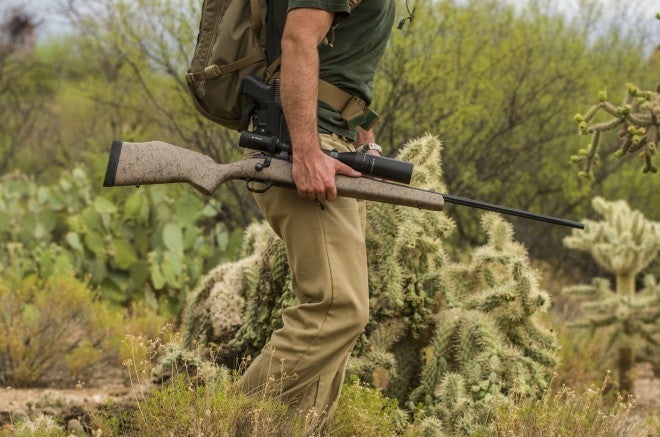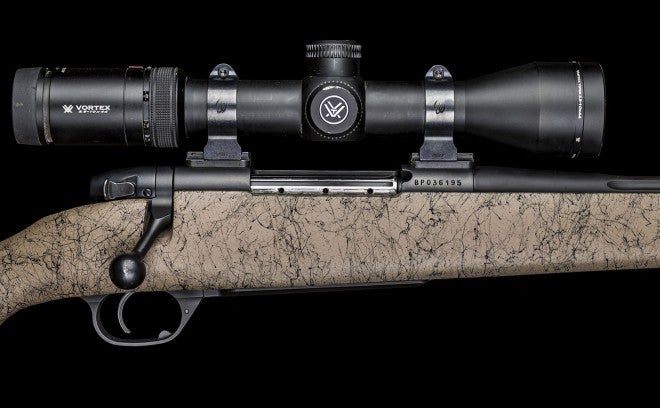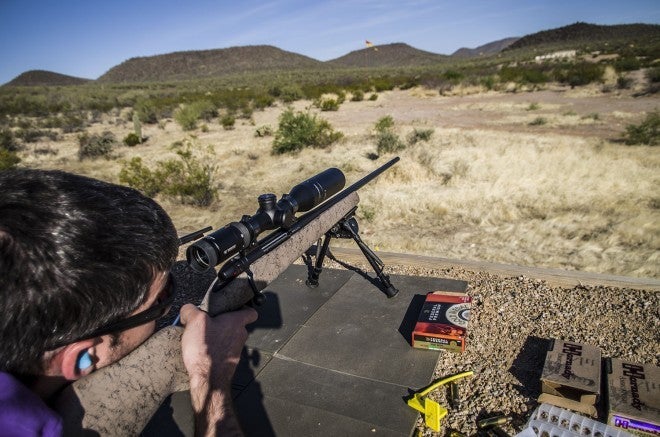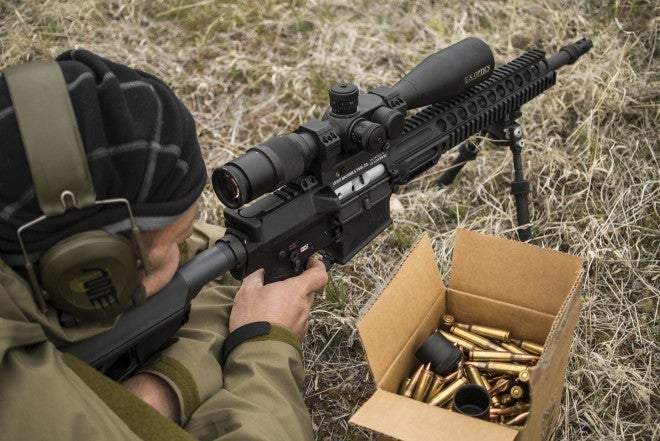Weatherby Mark V Ultra Lightweight .308 Win
 I am somewhat fanatical about keeping the weight of the items I carry over long distances as low as is practical. I’ve learned over the years that I can hike farther, faster, and be more well rested when I reach my destination if I don’t carry too much stuff. This lesson was learned the hard way during my time in the military, although a lot of the time I didn’t have a choice. Very little thought is given by those in control of such things to understanding how the individual components of a serviceman’s fighting load need to work in harmony or enable him to accomplish his mission without destroying his body in the process.
I am somewhat fanatical about keeping the weight of the items I carry over long distances as low as is practical. I’ve learned over the years that I can hike farther, faster, and be more well rested when I reach my destination if I don’t carry too much stuff. This lesson was learned the hard way during my time in the military, although a lot of the time I didn’t have a choice. Very little thought is given by those in control of such things to understanding how the individual components of a serviceman’s fighting load need to work in harmony or enable him to accomplish his mission without destroying his body in the process.
As a civilian, I have nearly complete freedom to choose which items I use and carry. This is both good and bad – yes, I have the freedom to make the right decisions, but I also have the freedom to make the wrong ones. If I carry too much stuff, I might not make it where I need to go, or I might not be able to hit my target when I get there. If I don’t carry enough stuff or I bring an inadequate item simply because it was light, I probably won’t be able to do what I need to do either.
It’s finding that balance that’s important – just enough to get the job done and not be completely miserable along the way. Enter the subject of this review, the Weatherby Mark V Ultra Lightweight chambered in .308 Winchester.
Weatherby provided me with this rifle nearly a year ago. I was hoping to use it during last year’s Sniper Adventure Challenge, but it arrived just a little too late; I held on to it longer than I intended to because I had hoped to use it in the same competition this year. As it turned out, I brought a lightweight AR-15 to the competition this year; nevertheless, I have spent a significant amount of time shooting and carrying this rifle, and feel qualified to discuss its performance in depth.
Weatherby Rifles
For those who may not be familiar with Weatherby, here’s a short primer. In the 1940s, Roy Weatherby was experimenting with ways to make more powerful – that is, faster – rifle ammunition. He developed a series of cartridges bearing his name which essentially represented the highest level of performance for a given caliber at the time, and many of his cartridges are still considered to be the fastest or most powerful in their class. Initially he used other rifle actions to test and build his creations, but in 1957 he designed a new rifle action, intending it to be incredibly strong and able to resist damage in the event of an ammunition failure. He called this new action the Mark V, as it was the fifth iteration of his design.
I have had previous experiences with Weatherby rifles: one of the first centerfire rifles I ever fired was a Mark V in .460 Weatherby. I fired it four times, and each time, it set off multiple car alarms in the shooting range parking lot. In addition, I own a Weatherby Vanguard, their entry-level rifle. It might be the most accurate off-the-shelf bolt action rifle I have ever owned.
Mark V Ultra Lightweight Details
This rifle appears to have been built with serious weight reduction as the primary consideration, which is why I requested it from Weatherby. Without a scope or rings, it weighed 5lbs 13 ounces on my scale. The button rifled barrel tapers down to under .550″ at the muzzle, and it’s also fluted! There are six longitudinal flutes running from approximately two inches forward of the throat to two inches short of the muzzle. Keep in mind that this is a .308, so per inch of barrel, it’s lighter than a lightweight AR-15 barrel in .223 Remington/5.56 NATO.
However, the Weatherby’s barrel is 24″ long, which I find somewhat puzzling. While a lot of people love to debate the proper barrel length for a .308, I think 24″ is just too long. I’ve seen semi-auto 16″ 308s make regular and repeatable hits on E type silhouettes at 800 yards. Even if Weatherby wanted to play it a little safe, they could have easily chopped the barrel down to 18″ or 20″ and not lost a ton of velocity. That would have made this rifle a lot more maneuverable in the brush, and saved even more weight. Obviously that wouldn’t have been as much of an option for a cartridge such as .300 Weatherby Magnum, but to me, a 24″ .308 barrel is past the point of diminishing returns – especially when weight reduction is a primary consideration.
However, the Weatherby’s barrel is 24″ long, which I find somewhat puzzling. While a lot of people love to debate the proper barrel length for a .308, I think 24″ is just too long. I’ve seen semi-auto 16″ 308s make regular and repeatable hits on E type silhouettes at 800 yards. Even if Weatherby wanted to play it a little safe, they could have easily chopped the barrel down to 18″ or 20″ and not lost a ton of velocity. That would have made this rifle a lot more maneuverable in the brush, and saved even more weight. Obviously that wouldn’t have been as much of an option for a cartridge such as .300 Weatherby Magnum, but to me, a 24″ .308 barrel is past the point of diminishing returns – especially when weight reduction is a primary consideration.
The action itself is a slightly simpler version of the original Mark V, for Weatherby found no reason to have nine locking lugs on non-magnum caliber bolts. This one features six locking lugs, which is still…well, it’s still a lot of locking lugs. Most modern bolt action rifles have two or three locking lugs, albeit larger ones than those found on the Weatherby. As a result, the Mark V action feels a bit different than other bolt action rifles.
It’s a push feed, cock-on-open design, which is fairly standard, but when the striker is cocked, the bolt wants to come to the rear before it’s fully unlocked unless you keep some forward pressure on the bolt handle as you rotate it. If you simply pull the handle upwards, the bolt will pop back a fraction of an inch at approximately 80% of the fully unlocked position, requiring that you add a little more pressure to rotate it to the full unlocked position. After you’ve fired a round (or allowed the striker to go forward via dry fire), you won’t feel that notch, but you will notice that it requires significant effort to unlock the bolt. In comparison to the Weatherby Vanguard, Tikka T3, Remington 700, and Steyr Safebolt I had on hand for friends to try, the unanimous opinion was that the Mark V required the most effort to unlock after firing.
One advantage of having more than two locking lugs, though, is a shorter bolt throw angle. The Mark V has a short bolt throw of only 54 degrees, which is far less than the 90 degree throw of a Remington 700. In addition to simply being shorter and theoretically faster, a shorter bolt throw means less interference with large scopes mounted low to the action. If you’re deciding on an action, one consideration is whether putting more effort into a shorter distance is worthwhile. For any sort of hunting situation involving dangerous game, I would much rather have a shorter bolt throw. For lots of shooting in the prone during a long range match, I would rather be lazy and not have to hold on to the rifle with my non-firing hand while unlocking the bolt.

With a Vortex Viper HS 2.5-10×44 in Talley rings, the Mark V Ultralight felt like an awesome short to mid range hunting rifle.
The Weatherby features a two position safety on the right side of the bolt sleeve, just forward of the cocking indicator at the rear of the bolt. Forward is on safe, which also locks the bolt in place. There are three vent holes along the side of the bolt to relieve pressure in the event that things get a little too hot, and of course the “three rings of steel” which encircle the case head – the recessed bolt face, the barrel, and the receiver. It is said that the Mark V action will withstand up to 200,000 CUP, a claim which I would not like to test while holding the rifle. However, having read many reports of the destructive testing of rifles and having conducted a few of my own, I am quite impressed with the results of Mark V pressure testing.
The trigger was slightly heavier than my other bolt action rifle triggers. Weatherby says that the trigger is 3.5lbs and advises that it should not be adjusted by anyone short of a qualified gunsmith. I felt the tiniest bit of creep just before the trigger broke, but it did not seem to be significant enough to affect my shooting in that I had to pay very close attention to even feel that it was evident. That said, I inspected a few Mark Vs in various stores, and all of them seemed to have “better” triggers than this example.
The trigger was slightly heavier than my other bolt action rifle triggers. Weatherby says that the trigger is 3.5lbs and advises that it should not be adjusted by anyone short of a qualified gunsmith. I felt the tiniest bit of creep just before the trigger broke, but it did not seem to be significant enough to affect my shooting in that I had to pay very close attention to even feel that it was evident. That said, I inspected a few Mark Vs in various stores, and all of them seemed to have “better” triggers than this example.
Performance of the Mark V Ultra Lightweight
I have to say that I was a little disappointed with the performance of this Mark V. I don’t know why I expected it to be an absolute tackdriver – perhaps because my other Weatherby is – but it proved to be somewhat less than that. I did expect it to be moderately unpleasant to shoot, which it was.

The Mark V Ultra Lightweight is not a match rifle – nor was it intended to be.
With Federal Gold Medal Match 168gr ammunition at 600 yards, I was unable to match the performance of my other .308 rifles over the course of a 40 shot prone match. After approximately ten to fifteen shots, I noticed a point of impact change of two to three feet at 600 yards. Closer in, I was unable to fire a ten shot group of less than 2 inches at 100 yards with any type of match ammunition. Weatherby representatives told me that the barrel was not free floated because this improved accuracy with such a light barrel; I would question how much worse it could be.
Then again, it wasn’t built as a match rifle. It was intended to be a lightweight hunting rifle that could put a single bullet through the vital zone of an animal at a reasonable hunting distance. Given a 2″ 10 shot group and an 8″ vital zone, plus a margin of safety for human error, I’d say that 300 yards is about as far as I would be comfortable taking a shot against a game animal with the Mark V Ultra Lightweight. This brings me back to the barrel length – I don’t need the minor velocity bump provided by a 24″ .308 barrel to hit something at 300 yards.

If a 16″ gas operated .308 can hold 1 MOA to at least 800 yards, why does a bolt action need a 24″ barrel to hold 2 MOA at 400?
So with the rifle delivering acceptable accuracy for hunting purposes, if not the match accuracy I would hope for from a rifle with a $2100 MSRP, what other performance metrics are there to discuss?
The first thing that comes to mind is reliability. I did not technically encounter any malfunctions, but I did have a few problems. I believe that there was a single cause – some sort of chamber dimension being ever-so-slightly on the smaller side. I had one popped primer with factory (S&B) ammunition, and extremely difficult extraction with several brands of match and hunting ammunition. This difficulty would have prevented a rapid followup shot, as it took five to ten seconds to pull the rifle out of my shoulder, tuck the stock under my arm, and rip upwards on the bolt handle in order to unlock the bolt and pull it to the rear before repeating those steps in reverse order.
This problem seemed to be slightly alleviated by a very thorough cleaning, but it was noticeable even when the rifle was brand new and clean as well as when it had been fired hundreds of times and then cleaned.
However, with Federal Gold Medal or PNW Arms Match ammunition, I did not have to put nearly as much effort behind unlocking the bolt. This problem might be a result of tolerance stacking on both sides: ammunition and rifle. I’m not quite sure and I haven’t done a chamber cast to find out. While the problems did stop me from carrying the rifle in a few situations, I felt confident in carrying the rifle in the field whenever I had FGMM.
However, with Federal Gold Medal or PNW Arms Match ammunition, I did not have to put nearly as much effort behind unlocking the bolt. This problem might be a result of tolerance stacking on both sides: ammunition and rifle. I’m not quite sure and I haven’t done a chamber cast to find out. While the problems did stop me from carrying the rifle in a few situations, I felt confident in carrying the rifle in the field whenever I had FGMM.
Final Thoughts
This Mark V did not quite live up to my expectations, which I found a little disappointing. It appeared on initial inspection to be very well made, to include an essentially perfect finish, very positive engagement of all controls, even and consistent fitment/assembly of components to one another, and nothing loose or out of place. Weatherby included nice touches such as an engraved W on the bottom of the trigger guard, bottom metal and a trigger guard that was actually metal, and so on. There appeared to be none of the cost-saving features used on lower-priced rifles.
If I hadn’t encountered the extraction problems, I’d be willing to overlook the accuracy issues and give the rifle a solid thumbs up. If I hadn’t encountered the extraction problems and the rifle had a shorter barrel, I would probably be yelling at Weatherby to take my money and not ask me what happened to their T&E rifle. If I hadn’t encountered the extraction problems and the rifle had a shorter barrel which was also thicker and free floated (and therefore hopefully more accurate), AND it took AI detachable magazines, I might not ever buy another .308 bolt action.
